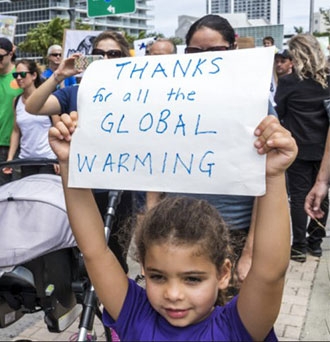
It’s hard to imagine an election year more chaotic than 2020. Congress impeached the president, a pandemic killed more than 200,000 Americans and left tens of millions jobless, racial violence and fascism are on the rise, and the battle to replace Justice Ruth Bader Ginsburg began the very night she died -- when voting was already underway.
And yet amidst all this chaos, one thing has remained constant: the newfound, and astonishing, power of climate voters. A recent NPR/PBS/Marist poll reveals that, even seven months into a deadly global pandemic, a stunning 12% of likely presidential voters still list climate change as their number one priority, after only the economy (21%) and coronavirus (13%). With numbers like these, large blocks of climate voters in battleground states could easily end up deciding the election.
Four years ago, it was hard to imagine climate voters wielding this much power. In 2016, only 2% of likely presidential voters listed “climate or the environment” as their top priority, and millions of environmentalists didn’t even bother to vote.
These paltry numbers gave cover to candidates, debate moderators and the media to essentially ignore the climate crisis throughout the 2016 election, and for much of 2017 and 2018 things weren’t much different. President Trump pretended the climate crisis didn’t exist, while congressional Democrats didn’t even mention climate once in their response to Trump’s first State of the Union.
But about half-way through 2018, the climate-voter movement began to awaken, largely thanks to first-time environmental voters who were newly politicized by President Trump’s environmental positions. A crop of Democratic congressional candidates, including Sean Casten, Mike Levin and especially Alexandria Ocasio-Cortez, added life to this movement by focusing on climate change as a signature issue. And in a sign that voters (not just candidates) were driving this new focus, even the National Republican Congressional Committee got into the game, highlighting climate change in an attempt to win races in climate-conscious South Florida. The NRCC even went so far as to misleadingly claim that a Democratic challenger had taken donations from the coal industry.
Of course, the NRCC didn’t just wake up one morning in 2018 and decide to drink the green Kool-Aid. Rather, they saw something in their polling and they did what politicians do -- they followed the voters. Indeed, 2018 exit polling revealed that a surprising 7% of midterm voters now listed environmental issues as their top priority.
This trend continued through 2019, when Environmental Voter Project research found that 12% of voters listed climate or the environment as their top priority. And, unsurprisingly, a bevy of Democratic presidential aspirants scrambled to earn those voters’ support by making climate leadership a focus of their presidential primary campaigns (and in some cases, the singular focus: see Washington Gov. Jay Inslee).
Fast-forward three months to March 2020, when coronavirus hit and American life screeched to a halt. Even at this moment of tremendous personal, political and economic turmoil, the new block of climate voters held steady, prioritizing environmental issues above all else. These climate voters (disproportionately made up of young people and people of color) aren’t usually reliable voters in primaries, butthey flexed their muscles at the ballot box throughout the summer, carrying progressives like Jamaal Bowman and Ed Markey to victory.
And now climate voters make up a stunning 12% of the likely presidential electorate. If, as many pundits predict, presidential turnout breaks 150 million voters this fall, that 12% would equal approximately 18 million “climate-first” voters casting a ballot, more than triple the number of NRA members.
This new power of climate voters is visible at the forefront of the presidential campaign. While nominees traditionally tack to the center after winning their party’s nomination, Joe Biden has moved to the left on climate. After significantly beefing up his climate plan, he made a strikingly direct appeal to climate voters: “I want young climate activists, young people everywhere, to know: I see you. I hear you. I understand the urgency, and together we can get this done.”
Even Donald Trump, a persistent climate-denier, seems to understand the shift. Back in 2017, he promised to open nearly all U.S. coastal water to oil and gas drilling, but he recently flew to Florida to announce an expanded moratorium on off-shore oil drilling in certain states, declaring himself to be “the number 1 environmental president” since Teddy Roosevelt.
You don’t need to believe Donald Trump’s claims of environmental leadership to see what’s going on here: climate voters are emerging as one of America’s largest voting blocks, and politicians are paying attention. The climate movement’s political power is growing, and politicians are increasingly viewing environmental leadership as a political necessity, rather than a policy choice. And this is exactly the type of power dynamic the climate movement needs.
Best of all, this dynamic could be particularly impactful in swing states. Recent polling shows that 89% of Floridians are concerned about climate change, including 86% of Republicans. Seventy-six percent of Pennsylvanians consider climate change to be a “serious problem,” with nearly half calling it “very serious.” And, perhaps most interestingly, recent polling in Arizona, North Carolina, Maine and Iowa by Data for Progress reveals that bold climate leadership could be the best way to appeal to swing voters in U.S. Senate races.
In short, the era of the climate voter has arrived. This may be news to people who haven’t tuned into politics since 2016, but these are the facts: climate change is now a top-3 voter priority, climate voters are turning out in unprecedented numbers, and battle-ground state voters of all stripes are deeply concerned about the climate crisis.
In 2020, politicians ignore climate voters at their peril.
------
Nathaniel Stinnett is the founder and executive director of the Environmental Voter Project, a non-partisan nonprofit that uses big data and behavioral science to turn environmentalists into better voters. He lives in Boston, Massachusetts with his wife and two daughters.
